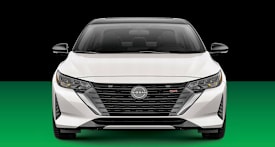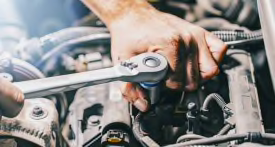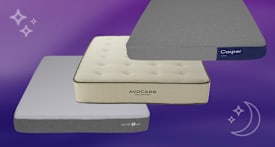The three-row midsized Traverse was redesigned for the 2024 model year, adopting a more traditional SUV-like appearance instead of the minivan-evoking style of its predecessor. Besides the new sheetmetal, the other big change is the switch from the prior V6 engine to a more powerful turbocharged four-cylinder. The reworked interior is outfitted with large screens, and the Traverse boasts a lengthy roster of standard active safety and driver assistance features.
After our testing was complete, we think the latest Traverse remains a solid entry in the midsized three-row SUV segment. It isn’t the quietest, best-handling, or most refined in the category, but it does many things well. Its roomy cabin, spacious cargo area, and fairly comfortable ride are high points. But it has a big new demerit—its raspy-sounding turbocharged four-cylinder engine. It simply isn’t anywhere near as polished as the smooth old V6. That’s a shame, because the powertrain works just fine, with delay-free takeoffs, strong power, and a mostly smooth-shifting transmission. But as one of our testers noted, “This engine gets so unrefined and loud whenever you’re accelerating—it just doesn’t match the character of the rest of the vehicle.”
The engine’s uncouth sounds and elevated noise stand out so much from the old, sweet-running V6, that it frankly makes us a bit sad; it sours the experience in a vehicle that, before, had no major vices.
We bought a 2024 Chevrolet Traverse LT AWD for $49,460—anonymously from an area dealer, as we do with every vehicle we test—for the purpose of this road test review.
The big talking point for the Traverse is its smaller yet more powerful 2.5-liter turbocharged four-cylinder engine. The little mill produces an energetic 328 horsepower, which is 18 more horsepower than the previous 3.6-liter V6. In terms of power delivery, the new engine works well. It isn’t marred with any delays or abruptness off the line, instead providing strong and linear acceleration. But the engine often sounds like it’s laboring, based on its elevated and uncouth raspy snarl, anytime the revs rise above 3,000 rpm.
Acceleration remains competitively quick within the three-row midsized SUV class, and in fact its 7.3-second 0-to-60-mph time exactly matches the previous, V6-powered version. Unfortunately, and in spite of the switch to a smaller four-cylinder, fuel economy remains at the same mediocre 20 mpg overall. Further insult to injury is that some rival V6-powered SUVs get better fuel economy.
We found it odd that Chevrolet programmed the Traverse so that you can’t use the paddle shifters behind the steering wheel to manually shift the transmission until you first press a small “L” button on the steering wheel. Not only is this annoying, for example if you want to get a quick downshift to help control the vehicle’s speed on a long downhill, but we’re guessing many owners will never understand what the button means, and may wonder why their paddle shifters don’t work.
The powertrain may have some oddities, but Chevy found a nice suspension setup out on the road. The Traverse has a settled and controlled ride, and sails smoothly over all kinds of surfaces. For a sizable SUV, the handling is solid—the steering has decent precision, and the Traverse proved secure when pushed to its limits around our track. Oddly, models with the optional all-wheel drive (rather than standard front-wheel drive) get delivered in front-wheel-drive mode; the owner has to press an “AWD” button on the driver’s left dash area in order to engage all-wheel drive. Once engaged, at least, it stays on indefinitely.
Panic-brake stopping distances proved competitive with other midsized three-row SUVs, and our drivers found the brake pedal pretty easy to modulate for smooth stops out on the road, beyond a bit of an abrupt initial response when you first step on the pedal, particularly at very low speeds.
Wind and road noise are kept nicely at bay inside the Traverse, but the aforementioned engine noise brings down the whole atmosphere, creating a din unbefitting of a $50,000 vehicle. Our mid-level LT’s cabin is rather plain and businesslike, but inoffensive. While there are some tasteful stitching and chrome trim accents here and there, there are too many hard plastic panels for its price. It was particularly disappointing to find exposed wiring and rough cutouts in the carpet around the second-row captain’s chairs when we slid them forward to get into the third-row seat.
There’s generous headroom up front, and both the door- and center armrests are well-placed, though light on padding. We found the left footrest to be too close and upright for optimal comfort, causing some drivers to move the seat rearward so as to not feel cramped. Some of our drivers struggled to find good comfort with the front seats. The main issue is the seat’s flat shape, which makes it feel more like you’re sitting on it than in it. Plus, some drivers felt that there was too much built-in lumbar support poking into their lower back. Front passengers were surprised to find all-manual seat controls at the Traverse’s price.
Outward visibility is aided by large windows most of the way around the vehicle, but it’s hampered by thick windshield pillars, which force the driver to move their upper body to see around them through turns. We’re not thrilled that the third side windows are compromised by a shark-fin-like body panel that diminishes the view purely in the name of styling.
Both seven- and eight-passenger configurations are available in the Traverse, depending on whether you go with a conventional second-row bench seat or dual captain’s chairs, like in our test vehicle. While captain’s chairs bring greater space and typically better comfort over a bench seat, note that this layout means a fifth occupant will always be relegated to the third row. As with most competitors, the Traverse’s third-row seat is best reserved for kids, due to tight head- and kneeroom.
As expected in a vehicle well-suited to road trips, small-item storage in the cabin is quite good. The front door pockets are deep and fairly wide, and there are well-defined bottle holders that don’t compromise the rest of the pocket. There’s an open bin underneath the center console that is a little tricky to access, but it could come in handy for the right items. Opening the rear liftgate reveals a significant amount of space behind the upright third-row seat, plus there is a deep underfloor storage cubby.
Almost all controls are handled through the large, 17.7-inch infotainment touchscreen, including media, navigation, and the headlights. Chevrolet's latest software integrates Google products such as Maps and Google Assistant. In spite of its massive size, the screen is crowded with icons and tiny buttons, which are difficult to select while driving and make the whole screen seem visually overwhelming. Numerous shortcuts line the outer edges of the screen, which further add to the clutter.
We were happy to see that most climate functions can be easily adjusted with physical buttons and dials, though some common features—such as the seat heaters and “sync”—must still be done through the touchscreen. We also found that the low-mounted center dash vents tend to supply air to the driver’s elbows, at the expense of sending it to your upper body and face.
Some other controls are either inconvenient or unintuitive. For example, the left steering wheel stalk has a complicated secondary function for the windshield- and rear-window wipers, often leading to accidental activations. The right stalk serves as the electronic gear selector, and its operation can take some getting used to. We also don’t like that the emergency flashers button is hidden high up on the overhead console. Not only is the button small, but its out-of-view location makes it difficult to find quickly in an emergency situation.
Active safety & driver assistance
Standard active safety and driver assistance features include automatic emergency braking with pedestrian and cyclist detection, automatic emergency braking that operates at highway speeds, blind spot warning, rear cross traffic warning, reverse automatic emergency braking, lane departure warning, lane keeping assistance, adaptive cruise control, and automatic high beams.
General Motors’ excellent Super Cruise active driving assistance system, which combines adaptive cruise control and lane centering assistance, is available on the Traverse, and was equipped on our test model. The system allows for hands-free driving on pre-mapped highways, and we think it’s a good stress-reliever—particularly in congested traffic. The system is also capable of changing lanes to get around slower vehicles on its own.
We’re happy to see that both a rear occupant alert system and a belt minder come standard. The former is designed to remind the driver—based on rear-door logic—to check the rear seat when they turn the Traverse off to help prevent children and pets from suffering heatstroke or hypothermia if unintentionally left behind in the vehicle. The rear belt minder alerts the driver if a rear passenger unbuckles their seat belt during the trip.


























